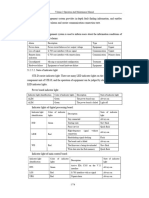Evolution of Cloud Computing
1. Mainframe Computing(1950-1970)
Mainframes which first came into existence in 1951 are highly powerful and reliable computing
machines. These are responsible for handling large data such as massive input-output operations.
Even today these are used for bulk processing tasks such as online transactions etc. These systems
have almost no downtime with high fault tolerance. After distributed computing, these increased the
processing capabilities of the system. But these were very expensive. To reduce this cost, cluster
computing came as an alternative to mainframe technology.
2. Distributed Systems(1970-1980)
Distributed System is a composition of multiple independent systems but all of them are depicted as
a single entity to the users. The purpose of distributed systems is to share resources and also use
them effectively and efficiently. Distributed systems possess characteristics such as scalability,
concurrency, continuous availability, heterogeneity, and independence in failures. But the main
problem with this system was that all the systems were required to be present at the same
geographical location. Thus to solve this problem, distributed computing led to three more types of
computing and they were-Mainframe computing, cluster computing, and grid computing.
3. Cluster Computing(1980-1990)
In 1980s, cluster computing came as an alternative to mainframe computing. Each machine in the
cluster was connected to each other by a network with high bandwidth. These were way cheaper
than those mainframe systems. These were equally capable of high computations. Also, new nodes
could easily be added to the cluster if it was required. Thus, the problem of the cost was solved to
some extent but the problem related to geographical restrictions still pertained. To solve this, the
concept of grid computing was introduced.
�4. Grid Computing(1990-2000)
In 1990s, the concept of grid computing was introduced. It means that different systems were placed
at entirely different geographical locations and these all were connected via the internet. These
systems belonged to different organizations and thus the grid consisted of heterogeneous nodes.
Although it solved some problems but new problems emerged as the distance between the nodes
increased. The main problem which was encountered was the low availability of high bandwidth
connectivity and with it other network associated issues. Thus. cloud computing is often referred to
as "Successor of grid computing".
5. Utility Computing(Late 1990-2000)
Utility Computing is a computing model that defines service provisioning techniques for services
such as compute services along with other major services such as storage, infrastructure, etc which
are provisioned on a pay-per-use basis.
6. Virtualization(1980-Present)
Virtualization was introduced nearly 40 years back. It refers to the process of creating a virtual layer
over the hardware which allows the user to run multiple instances simultaneously on the hardware.
It is a key technology used in cloud computing. It is the base on which major cloud computing
services such as Amazon EC2, VMware vCloud, etc work on. Hardware virtualization is still one of the
most common types of virtualization.
7. Web 2.0
Web 2.0 is the interface through which the cloud computing services interact with the clients. It is
because of Web 2.0 that we have interactive and dynamic web pages. It also increases flexibility
among web pages. Popular examples of web 2.0 include Google Maps, Facebook, Twitter, etc.
Needless to say, social media is possible because of this technology only. It gained major popularity
in 2004.
8. Service Orientation
A service orientation acts as a reference model for cloud computing. It supports low-cost, flexible,
and evolvable applications. Two important concepts were introduced in this computing model. These
were Quality of Service (QoS) which also includes the SLA (Service Level Agreement) and Software as
a Service (SaaS)
Cloud Computing
Cloud Computing means storing and accessing the data and programs on remote servers that are
hosted on the internet instead of the computer’s hard drive or local server. Cloud computing is also
referred to as Internet-based computing, it is a technology where the resource is provided as a
service through the Internet to the user. The data that is stored can be files, images, documents, or
any other storable document.





















































































